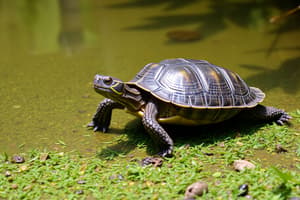Podcast
Questions and Answers
What class are sea turtles in?
What class are sea turtles in?
Reptilia
Which of the following are included in Class Reptilia? (Select all that apply)
Which of the following are included in Class Reptilia? (Select all that apply)
- Sea turtles (correct)
- Birds
- Lizards (correct)
- Crocodilians (correct)
What characteristics do all reptiles share? (Select all that apply)
What characteristics do all reptiles share? (Select all that apply)
- Gills
- Epidermal scales (correct)
- Warm-blooded
- Vertebral column (correct)
What are the comparative sizes of sea turtles? (Select all that apply)
What are the comparative sizes of sea turtles? (Select all that apply)
Sea turtles first appeared 200 million years ago.
Sea turtles first appeared 200 million years ago.
How do sea turtles manage salt intake?
How do sea turtles manage salt intake?
How long can green turtles stay underwater?
How long can green turtles stay underwater?
What is the ventral side of a sea turtle's shell called?
What is the ventral side of a sea turtle's shell called?
What is the function of the sea turtle's front flippers?
What is the function of the sea turtle's front flippers?
What is the primary function of a sea turtle's cloaca?
What is the primary function of a sea turtle's cloaca?
What are the single keratinous scales on a sea turtle's shell called?
What are the single keratinous scales on a sea turtle's shell called?
What is the dorsal side of a sea turtle's shell called?
What is the dorsal side of a sea turtle's shell called?
How many chambers does a turtle's heart have?
How many chambers does a turtle's heart have?
What body systems help a sea turtle with salt and water balance?
What body systems help a sea turtle with salt and water balance?
How do sea turtles breathe?
How do sea turtles breathe?
Study Notes
Class and Definition
- Sea turtles belong to the class Reptilia, derived from the Latin word meaning "to creep."
- Other members of the Reptilia class include crocodilians, snakes, lizards, and dinosaurs.
Shared Characteristics of Reptiles
- Possess a vertebral column indicating they are vertebrates.
- Feature epidermal scales, which protect internal organs and reduce water loss.
- Air-breathing through lungs; unlike fish, reptiles do not have gills.
- Ectothermic (cold-blooded), requiring basking for warmth.
- Reproduce via internal fertilization, with all sea turtles laying eggs.
Sea Turtle Sizes
- Leatherback: 12 feet
- Green sea turtle: 4 feet
- Loggerhead: 3.8 feet
- Hawksbill: 3.2 feet
- Olive ridley: 2.8 feet
Evolutionary History
- Sea turtles originated in the lower Mesozoic Era, with fossils dating back 112 million years to the middle Cretaceous period.
- Land turtles first appeared 200 million years ago, with only two families of the original four still existing today.
Adaptations to Sea Water
- Sea turtles are hypo-osmotic compared to seawater, losing water to the ocean.
- Their skin and shell resist water diffusion, and they drink seawater.
- Specialized salt glands near their eyes excrete excess salt.
Metabolism and Diving
- Sea turtles have an adjustable metabolism to extend underwater capacity.
- Green turtles can stay submerged for up to 5 hours; hawksbills can manage about 45 minutes.
Anatomy Overview
- Plastron: The ventral side of the shell, connected to the carapace via cartilage.
- Flippers: Front flippers serve as wings and propellers, while back flippers act as rudders for steering and nest digging.
- Cloaca: A structure beneath the tail for excretory and reproductive functions, facilitating internal fertilization.
Shell Structure
- Scutes: Keratinous scales over the carapace, which help identify different sea turtle species based on their arrangement.
- Carapace: The dorsal part of the shell, fused with backbone and ribs (except leatherbacks).
Circulatory System
- Sea turtles have a three-chambered heart, where deoxygenated blood collects in the right atria and is pumped to the lungs for oxygen before returning to the body.
Osmoregulation
- Comprised of salt glands and kidneys, the osmoregulatory system manages salt and water balance within the body.
Breathing Adaptations
- Sea turtles have multi-chambered lungs, allowing efficient oxygen exchange.
- Breathing involves the movement of pectoral and pelvic muscles to compress the lung area, facilitating inhalation and exhalation.
- Leatherbacks uniquely store oxygen for deep dives within blood and tissues rather than primarily in the lungs.
Studying That Suits You
Use AI to generate personalized quizzes and flashcards to suit your learning preferences.
Description
Explore the fascinating world of sea turtles and their classification within the Reptilia class through these informative flashcards. Each card presents key characteristics, fun facts, and related reptilian species. Perfect for anyone looking to deepen their understanding of these incredible creatures.




